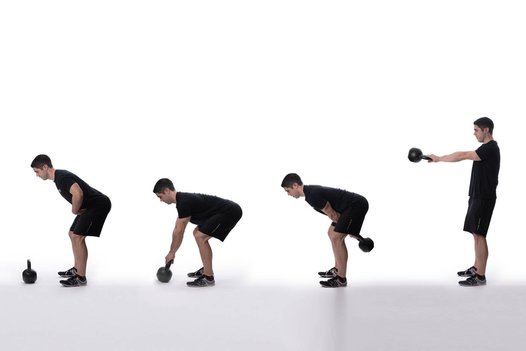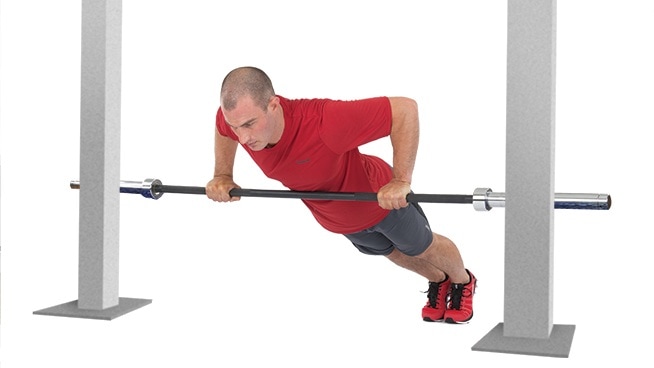|
In today's installment of the supplemental and accessory exercise series, I discuss the hinge pattern and my favorite exercise to use early on as a regression to teach the hinge, in addition to my two favorite exercises used to build the barbell deadlift.
Using The Kettle Bell Swing To Teach Proper Hinging Teaching a proper hinging of the hips while keeping the spine neutral can be very easy, but often times it is made to be much harder than it actually has to be. Once a proper hinge progression is taught (I may discuss this in a future article), the kettle bell swing is one of my favorite exercises to use in order to help rehearse the pattern, as it is very repeatable and simplified. In addition, using the kettle bell swing can ensure that you are not placing tremendous amounts of stress on your spine if your form is not fully cleaned up and mastered. Basically, the downward momentum of the kettle bell during the eccentric portion of the range of motion forces the hips to hinge into proper position. I also like the kettle bell swing because in order to achieve a full lockout with your arms and drive the kettle bell to the top you will need to finish your hinge (think a driving forward of the hips and a tensing of the glutes as you get to the top and lock your knees). When using a heavier kettle bell your arms may not be enough to drive it up alone, and this can really require you to make sure that you are properly finishing off your hinge. For beginners and lifters or athletes who are trying to build strength with this range of motion I would recommend using repetition ranges in the 8-12 range. This will help pack on added muscle mass in the posterior chain (glutes, hamstrings and hips), which will allow strength potential to be much higher when moving on to a traditional deadlift. Two Best Exercises To Build The Hinge and Deadlift (Romanian Deadlift and Rack Pulls) As I said early on in this blog series, our goal with supplemental exercises is to build muscle and strength with exercises that involve the same muscle groups utilized with primary movements, but is also performed in the same movement pattern. Thus, supplemental exercises to build the deadlift should incorporate a hinge and only a slight alteration from a tradition full range deadlift. For example, the two exercises I am about to discuss differ from the deadlift in a few minor areas, which I will explain.
1 Comment
The first fundamental movement covered in our supplemental and accessory exercise series will be the push, which is most commonly associated with the bench press and push-up. So, as part of our supplemental exercise recommendations the following exercises will be focused on perfecting push form, and also building the barbell bench press. Remember, supplemental exercises are performed with the same movement pattern as the movement you are trying to improve.
The Best Way To Perfect Your Push-up and Pressing Form (The Barbell Push-up) The number one supplemental exercise to improve the push-up or press is the barbell push-up. The barbell push-up allows us to work with eccentrics and perfect push form due to the fact that we can alter our angle (higher angle is far easier) and progress as we improve our form and strength. Also, we can focus purely on eccentrics to improve. Basically, the strength curve shows we are stronger eccentrically (downward portion of the range of motion), so those who cannot perform regular push-ups properly can simply lower to the bar with good form, and then reset and perform more reps in that manner. I generally do not advise to “push-up” off the bar until proper form can be executed. Top Two Supplemental Exercises To Improve Your Barbell Bench Press (Board Press and Pause Repetitions/Thick Bar Work) These two exercises will help with your not only your lockout but also your ability to get the weight off your chest. The first exercise is a board press in which you limit the range of motion to the top half or third of the press and work on your triceps and shoulder strength while perfecting the lockout. Many athletes and lifters struggle getting the bar to full lockout, and performing the board press for either hypertrophy purposes or even strength can go a long way. The next exercise or supplemental variation I like to incorporate is thick bar work with a pause on the chest. I have used these together for tremendous success in my own training and with my athletes. Thick bar work (fat gripz are the cheapest way to go about this), can stimulate the nervous system and improve handling of the bar (while also strengthening grip and wrists). In addition, a pause on the chest can limit momentum and strictly focus on the ability to drive the bar off the chest in the early portion of the range of motion. Repetition Ranges for Supplemental Exercises For athletes or lifters who need to or can afford to gain weight, supplemental exercises can be used to gain muscle mass (12-15 reps). For athletes who need to maintain or even lose weight they can be performed for max strength and in the 1-5 repetition range. |
AuthorSGerry DeFilippo: ISSA CPT- CPPS, AAPS. Founder/Owner: Challenger Strength. Archives
October 2020
Categories
All
|



 RSS Feed
RSS Feed